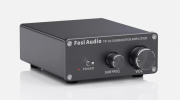I have a Red Dragon Audio S500 running my surrounds but it seems the company has finally closed shop.
I believe it’s based on a Pascal module
I believe it’s based on a Pascal module
Okay. I didn't see that.IIRC it was decided not to include pro amps in this list, which would exclude all but the MX-D1.
Those power specs are almost as slippery as the ones we see for cheap chip amps. No distortion level is given, and duration is very short:
We need a larger picture of the blue ones with links to Amir’s reviews pleaser!It'd be good to have a summary of each chip's know characteristics, like a reasonable guess at the power level, even if it's just relative to each other.
I want something equivalent to a 55w receiver, maybe up to like 90w at 8ohm Old School units. I need to keep going back thru the specs and tests of D class amps I already have here, and comparing them on the fly. I have a few old receivers that are rated at 35 to 55w and they are punchy.
Here's this... View attachment 395997
We need a larger picture of the blue ones with links to Amir’s reviews pleaser!
Specifications
Tuning range: FM, MW
Power output: 30 watts per channel into 8Ω (stereo)
Frequency response: 20Hz to 20kHz
Total harmonic distortion: 0.1%
Input sensitivity: 2.5mV (MM), 200mV (line)
Signal to noise ratio: 80dB (MM), 105dB (line)
Output: 200mV (line)
Speaker load impedance: 4Ω (minimum)



I just bought this... https://www.ebay.com/itm/295547827838
View attachment 396253 View attachment 396250
Yes, I actually do own a passive sub, a rare bird these days.
Class D amplifiers are analogue. The D does not stand for Digital. Class D amplifiers work through Pulse Width Modulation.Very curious why they have chosen for a digital variant instead of an analog technology?
I know as long as Class D amplifiers exist... But from the Bryston Brochure:Class D amplifiers are analogue. The D does not stand for Digital. Class D amplifiers work through Pulse Width Modulation.
Just check WIkipedia to get started on the topic.
The audio signal is first converted into a digital format by an ana-
log-to-digital converter (ADC). The digital signal is then pro-
cessed by a digital signal processor (DSP), which generates the
PWM signal based on the input signal.
Actually, I'd encourageClass D amplifiers are analogue. The D does not stand for Digital. Class D amplifiers work through Pulse Width Modulation.
Just check WIkipedia to get started on the topic.

 www.audiosciencereview.com
www.audiosciencereview.com
Thanks for your continuing hard work in compiling this list Doodski. I would suggest adding Rouge Audio Design to the list. They are based in Italy and build some gorgeous amps using Hypex, Icepower, Purify, Powersoft and Pascal modules. The range includes a cheaper Studio series and a more upmarket and pricier Alauda series of power amps.The list of known class D amplifiers is fairly complete without listing every pro amp or models on Alibaba or wherever those things are. If you can look over the list and see if anything comes to mind that is not on the list that would be great. Thanks.

ASR list of known class D home audio amplifiers.
Any suggestions are welcome. Post suggestions here. I will gather the details and add them. Thanks. :D This will be organized as results come in. So give me brand names and model numbers of class D amps and I'll create the list just like the EQ/PEQ webpage @ ASR is done. 3E Audio 260-2-29A PFFB...www.audiosciencereview.com
